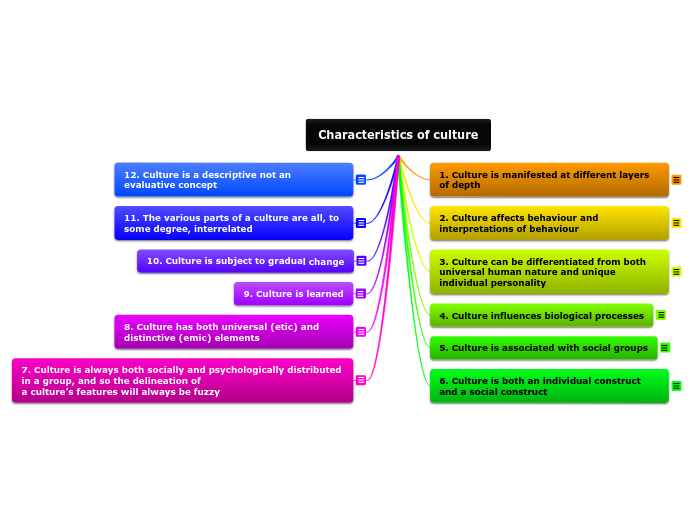arabera Alejandra Gonzalez Barrera 5 years ago
1449
Characteristics of culture

arabera Alejandra Gonzalez Barrera 5 years ago
1449

Honelako gehiago
Culture is a ‘fuzzy’ concept, in that group members are unlikely to share identical sets of attitudes, beliefs and so on, but rather show ‘family resemblances’, with the result that there is no absolute set of features that can distinguish definitively one cultural group from another.
Although some students of culture assume that every culture is unique and in some sense every person in the world is unique, science deals with generalizations.
Culture is learned from the people you interact with as you are socialized. Watching how adults react and talk to new babies is an excellent way to see the actual symbolic transmission of culture among people.
Culture changes gradually. It is not static. The forces of change are both internal and external and the mechanisms for change are discovery and invention. Most innovations introduced into a culture are the result of borrowing from other cultures. This process is known as cultural diffusion, the spreading of cultural items from one culture to another.
Cultures should be thought of as integrated wholes – that is, cultures are coherent and logical systems, the parts of which to a degree are interrelated.
Sometimes people talk of ‘high’ and ‘low’ culture. It is not that some cultures are advanced and polite while others are coarse and rude. Rather, they are similar or different to each other.
Culture is as much an individual, psychological construct as it is a social construct. To some extent, culture exists in each and every one of us individually as much as it exists as a global, social construct. Our failure in the past to recognize the existence of individual differences has undoubtedly aided in the formation and maintenance of stereotypes.
Culture is shared by at least two or more people.
The great majority of our conscious behavior is acquired through
learning and interacting with other members of our culture.
Culture is learned, not inherited. It derives from one’s social environment, not from one’s genes. Culture should be distinguished from human nature on one side, and from an individual’s personality on the other.
although certain aspects of culture are physically
visible, their meaning is invisible: ‘their cultural meaning'.this could often lead to cultural misunderstanding and misinterpretations.
Culture has three fundamental levels: a) observable artifacts,
b) values, and c) basic underlying assumptions.
A) Observable artifacts: This category includes everything from the physical layout, the dress code, the manner in which people address each other, the smell and feel of the place, its emotional intensity, and other phenomena, to the more permanent archival manifestations such as company records, products, statements of philosophy, and annual reports.
B)Values: Values that govern behavior: it is often necessary to infer them by interviewing key members of the organization or to content analyze artifacts such as documents and charters.
C) underlying assumptions: Typically unconscious but which actually determine how group members perceive, think and feel.